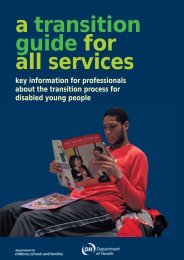NCEPOD: Trauma - Who Cares? - London Health Programmes
NCEPOD: Trauma - Who Cares? - London Health Programmes
NCEPOD: Trauma - Who Cares? - London Health Programmes
You also want an ePaper? Increase the reach of your titles
YUMPU automatically turns print PDFs into web optimized ePapers that Google loves.
CHAPTER 4 - Prehospital carecaused respiratory depression which was not adequatelymanaged by suitable respiratory support. In three cases withsignifi cant thoracic injuries Entonox was the analgesic usedand this was considered by the advisors to be inappropriatebecause of the risk of tension pneumothorax.One must question why the provision of analgesia in a groupof severely injured patients was so low (110/504 – 21.8%)?Patients with severe injuries are likely to experience pain and theprovision of analgesia to reduce this is a basic humanitarian aim.It is rare that contraindications exist to the provision of pain relief.Key findingsIn a third of cases (245/749), the ambulance patient reportform was not available.652/783 patients (83.3%) were transported to hospital byroad ambulance and 92/783 patients (11.7%) by helicopter.23/56 (41.1%) patients treated by a helicopter-basedsystem were intubated on scene compared to 32/440(7.3%) patients treated by a road ambulance system.None of the patients treated by a helicopter based systemwere taken to an inappropriate hospital compared to31/440 (7%) patients treated by a road ambulance systemwho were initially taken to an inappropriate hospital.Blood pressure was recorded in 398/504 (80%) casesdespite recommendations that this should not bemeasured in the prehospital phase.Only 46/170 (27.1%) patients who suffered a severe headinjury (GCS less than 9) were intubated prehospital.Only 110/504 (21.8%) patients were given analgesia in theprehospital phase.RecommendationsAll agencies involved in trauma management, includingemergency medical services, should be integrated intothe clinical governance programmes of a regional traumaservice. (All healthcare providers)Ambulance trusts should work together to standardisethe content and layout of the Patient Report Form(PRF), and ensure that it is fi t for purpose and facilitatescomparative audit. Clinicians must ensure that a PRFis received for every patient and secured in the medicalrecord. (Emergency medicine physicians and ambulancecrews)It is important that where guidelines exist, they are widelydisseminated to appropriate groups, and there is arobust system in place to monitor compliance with thoseguidelines. (Ambulance and hospital trusts)It is vital that all patients who have sustained serioustrauma should have a primary survey conducted atthe earliest opportunity, and that critical resuscitationinvolving airway, breathing and circulation (with cervicalspine control) should be undertaken and reviewedthroughout the prehospital phase of care. This must bedocumented. (Emergency medicine physicians)Airway management in trauma patients is oftenchallenging. The prehospital response for these patientsshould include someone with the skill to secure theairway, (including the use of rapid sequence intubation),and maintain adequate ventilation. (Ambulance andhospital trusts)Severely injured patients are likely to be in pain and theprovision of adequate analgesia is required. If analgesiais not given there should be a clear record in the PatientReport Form of the reasons for this. (Ambulance trusts)48
















